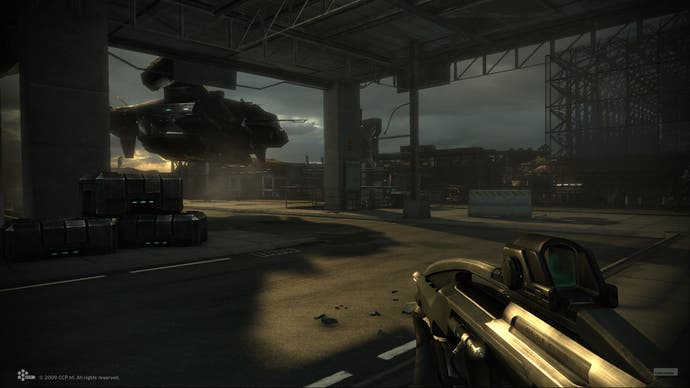DUST 514
Earth to earth.
Those battles take place on dynamic battlefields about 5 kilometres across. Unlike EVE itself, there will be a cap to the number of players per battle - CCP is "still playing with numbers" (and presumably watching the development of 256-player MAG with interest), but assures us that this will not be less than 64 players. There will be a command structure, with infantry and squadron leaders on each side led by a player-commander on board the hulking Mobile Command Centre airship.
The commander will effectively be playing a real-time strategy game with living units, and will have an RTS-style view of the battlefield. He'll be dependent on the situational awareness of infantry players to clear the fog of war. He'll also be the target, with the ultimate aim of a battle - after several, varying sub-objectives - being to destroy the opposing side's MCC.
To do that, players will need to use vehicles - we see a Warthog-style armoured buggy and a jet fighter in action - but also need their commanders to deploy ground installations, which can house missile launchers and rail-guns as well as serving as spawn points. Commanders and infantry alike will earn non-persistent War Points over the course of a single battle, which they can use to order in vehicles and installations - the aim being to give each fight an "escalation of war" and a crescendo of spectacle.

Surprisingly perhaps, CCP is shying away from a skill system or levels, as favoured by the other shooters that have flirted with massively multiplayer persistence and advancement. Instead, Sveinsson promises an "achievement matrix" where collected achievements unlock tiers that give access to better items from the market places. The focus - in the single direct game design parallel with EVE - is on a deep, modular system of fitting and customising weapons and vehicles which Sveinsson reckons will be "unprecedented" in FPS gaming.
Here, things get a little muddy, because money comes into it - both real and virtual. Naturally for EVE's ruthlessly capitalist universe, you'll be amassing wealth - in the same ISK currency as the PC players - and there will be a player-driven economy feeding into this customisation system. But you'll also be buying items for real money, through micro-transactions - because DUST will not charge a subscription fee, but CCP needs a steady source of income from the game because "we need to run servers and so on", says Sveinsson.

CCP is the first developer creating a console MMO to pin its business-model colours to the mast in this way; it will be interesting to see if others have the courage to follow suit. But Sveinsson can't yet be clear on where the line between micro-transaction items and in-game economy items will be drawn. Nor can he specify exactly where DUST's player economy and EVE's will overlap, although he is firm that to begin with, it will be restricted to a one-way flow of cash from PC to console.
"We do believe that it's better to release a regulated game when it comes to the economy and stuff, and then deregulate as we learn about it with the players," he says. "We'll start by doing something meaningful and awesome, and then make it more awesome." The caution is well-advised, but still CCP will need much more clarity on these issues to pacify EVE players, and to prevent either the micro-transactions devaluing the in-game marketplace or vice versa. It's quite a tangle. Good thing CCP has its own in-house economist.


.png?width=291&height=164&fit=crop&quality=80&format=jpg&auto=webp)




.jpg?width=291&height=164&fit=crop&quality=80&format=jpg&auto=webp)
